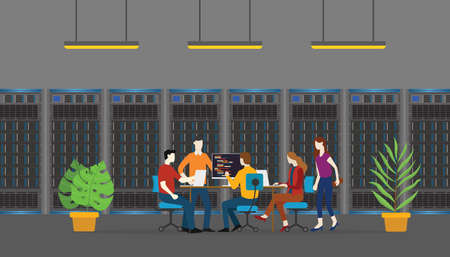Understanding the Value of Networking in the U.S. Job Market
In the United States, building a strong professional network is more than just collecting business cards or connecting on LinkedIn. It’s a key strategy for job seekers to find new opportunities, get referrals, and learn about positions that are never posted online. Understanding the unique aspects of networking in the U.S. can give you a real advantage in your job search.
Why Is Networking So Important?
Most jobs in the U.S. are filled through referrals and recommendations rather than traditional applications. This is sometimes called the “hidden job market,” where positions are offered to someone even before they are advertised to the public. American employers often trust personal recommendations from people they know, making networking a critical part of landing your next role.
The Hidden Job Market: How Jobs Are Really Filled
| Job Search Method | Percentage of Hires (Approximate) | Example |
|---|---|---|
| Online Applications | 20-30% | Applying through job boards like Indeed or company websites |
| Networking & Referrals | 60-70% | A friend refers you to their employer, or a connection alerts you to an unadvertised position |
| Recruiters/Agencies | 10-15% | Being contacted by a recruiter who found your profile online |
Cultural Expectations Around Referrals
In American workplace culture, it’s common and acceptable to ask your network for advice or introductions. People understand that referrals are a normal part of finding work, and many professionals are happy to help if you approach them politely and respectfully. Building genuine relationships—rather than just asking for favors—is encouraged.
Common U.S. Networking Practices
- Informational Interviews: Requesting short meetings to learn about someone’s career path or company.
- Professional Events: Attending conferences, meetups, or industry seminars to connect with others in your field.
- Online Networking: Using platforms like LinkedIn to reach out and maintain professional relationships.
- Email Introductions: Asking mutual connections to introduce you to potential employers or mentors.
Key Takeaway
If you’re searching for a job in the U.S., understanding the importance of networking—and embracing these cultural expectations—can open doors to opportunities you might never find through traditional job searching alone.
2. Leveraging LinkedIn and Social Media Effectively
Build a Strong Online Presence
Your online presence is your digital first impression. In the U.S., employers and recruiters often search for candidates on LinkedIn and other social media platforms before making contact. Make sure your profiles are up-to-date, professional, and reflect your personal brand.
Tips for Optimizing Your LinkedIn Profile
| Section | What to Include | Pro Tips |
|---|---|---|
| Profile Photo | Professional headshot | Avoid selfies; dress as you would for an interview |
| Headline | Your current role or desired position + industry keywords | Makes it easier for recruiters to find you |
| Summary/About | Brief story of who you are, your skills, and what youre seeking | Use first person (“I am…”) and keep it concise |
| Experience | Relevant work history with achievements and responsibilities | Use bullet points; quantify results where possible (e.g., “Increased sales by 20%”) |
| Skills & Endorsements | List top skills relevant to your field | Ask colleagues to endorse you; return the favor! |
| Recommendations | Written references from previous coworkers or managers | Request personalized recommendations highlighting specific strengths |
Engage with Industry Professionals
Connecting is just the first step—active engagement helps build genuine relationships. Here’s how you can interact meaningfully on LinkedIn and other platforms:
- Comment on Posts: Share thoughtful comments on updates from industry leaders or companies you admire.
- Share Content: Post articles, insights, or news relevant to your field to demonstrate knowledge and interest.
- Join Groups: Participate in LinkedIn Groups related to your profession or industry. This helps you meet new people and stay updated on trends.
- Congratulate Others: Celebrate others’ career milestones—such as promotions or work anniversaries—to show support and stay visible.
- Send Personalized Connection Requests: Always include a short note explaining why you want to connect (e.g., shared interests, mutual connections).
Sample Message for Connecting on LinkedIn:
Hello [Name],
I came across your profile while researching [industry/role]. I’m very interested in learning more about your experience at [Company] and would love to connect.
Sincerely,
[Your Name]
Use LinkedIn Features to Make Meaningful Connections
LinkedIn offers several tools beyond basic networking that can help you stand out in the U.S. job market.
| Feature | Description & How To Use It |
|---|---|
| Open to Work Badge | Add this badge if you’re actively job hunting; it signals recruiters that you’re open for opportunities. |
| LinkedIn Learning | Pursue courses relevant to your field; share certifications on your profile to showcase ongoing learning. |
| Job Alerts & Easy Apply | Create custom job alerts; use “Easy Apply” for quick applications using your profile info. |
| Mentioning & Tagging | Mention people or companies in posts/comments to increase visibility and foster engagement. |
The Role of Other Social Media Platforms
Besides LinkedIn, U.S. professionals often use Twitter, Facebook Groups, and even Instagram for networking—especially in creative fields. Always keep content professional, as employers may review public profiles during hiring processes.
A strong online presence, active engagement, and smart use of LinkedIn features will help you make authentic connections with industry professionals across the United States.

3. Making the Most of Professional Associations and Networking Events
Identifying Relevant Industry Events
Finding the right events to attend is key to building a strong professional network in the U.S. Start by researching both in-person and virtual events that fit your industry or career interests. Check out event platforms like Eventbrite, Meetup, or LinkedIn Events for local meetups, conferences, and workshops. Many professional organizations also list upcoming gatherings on their websites. Here’s a simple way to compare different types of events:
| Event Type | Benefits | How to Find |
|---|---|---|
| In-Person Conferences | Face-to-face connections, industry insights, workshops | Industry association sites, LinkedIn, company newsletters |
| Virtual Webinars | No travel needed, access to experts nationwide | Eventbrite, association websites, LinkedIn Events |
| Local Meetups | Casual networking, build community ties | Meetup.com, local chambers of commerce |
| Career Fairs | Meet recruiters, discover job openings | University career centers, company career pages |
Joining Professional Organizations
Professional associations are powerful resources for job seekers in the U.S. They often provide member directories, exclusive job boards, webinars, mentorship programs, and opportunities to volunteer on committees. Look for organizations relevant to your field—such as the American Marketing Association (AMA) for marketing professionals or the Society for Human Resource Management (SHRM) for HR practitioners. Membership fees can vary, but many offer student or early-career discounts.
Tips for Getting Involved:
- Attend Chapter Meetings: Local chapters host regular events where you can meet peers and leaders.
- Volunteer: Serving on a committee is a great way to showcase your skills and get noticed.
- Participate Online: Join association forums or social media groups to stay active and visible.
Interacting Confidently at Events
If networking feels intimidating, remember that most people are open to meeting new contacts. Prepare a brief introduction about yourself—your “elevator pitch”—and some questions you can ask others about their roles or experiences. At both in-person and virtual events:
- Arrive Early: Smaller crowds make it easier to start conversations.
- Listen Actively: Show genuine interest by listening carefully and asking follow-up questions.
- Exchange Contact Information: Bring business cards to in-person events or share your LinkedIn profile link at virtual ones.
- Follow Up: Send a quick thank-you message after meeting someone new to keep the connection alive.
Your Quick Networking Checklist:
- Select one event per month to attend (virtual or in-person)
- Create or update your LinkedIn profile before attending events
- Dare to introduce yourself to at least three new people at each event
- Join one professional organization relevant to your career goals this year
- Email or message new contacts within 48 hours after meeting them
4. Mastering the Art of Informational Interviews
What Is an Informational Interview?
An informational interview is a casual conversation with someone working in your field of interest. It’s not a job interview. Instead, it’s a chance to learn more about the industry, company culture, and career paths from someone with firsthand experience. In the U.S., informational interviews are a popular way for job seekers to build networks and gain inside knowledge.
How to Reach Out for Informational Interviews
Reaching out can feel intimidating, but most professionals in the U.S. are open to helping others, especially if you’re respectful and clear about your intentions. Here are steps to get started:
| Step | Tips |
|---|---|
| Identify Potential Contacts | Look for alumni from your school, people on LinkedIn, or professionals in industry associations. |
| Craft a Polite Message | Keep it short and specific—mention how you found them and what you hope to learn. |
| Be Flexible with Scheduling | Offer several time options and be understanding of their availability. |
| Follow Up | If they don’t reply after a week, send a gentle reminder. |
How to Conduct an Informational Interview
Once someone agrees to chat, prepare thoughtfully. Show respect for their time by being organized and punctual. Here’s how you can make the most of your meeting:
- Research beforehand: Know their background and the company they work for.
- Prepare questions: Write down what you want to learn (see examples below).
- Be on time: Punctuality is highly valued in U.S. business culture.
- Take notes: It shows respect and helps you remember details later.
- Thank them: Always send a thank-you note or email after your conversation.
Sample Questions to Ask During Informational Interviews
| Category | Example Questions |
|---|---|
| Their Career Path | “How did you get started in this field?” “What was your career journey like?” |
| The Company/Industry | “What do you enjoy most about working here?” “What trends do you see in this industry?” |
| Advice for Job Seekers | “What skills do employers value most?” “Do you have tips for someone looking to break into this field?” |
| Cultural Insights | “What is the work culture like at your company?” “Are there common mistakes newcomers make?” |
Nurturing Professional Relationships Afterward
Your work doesn’t end when the meeting does. Building a strong professional network in the U.S. means staying in touch and showing genuine appreciation. Here’s how:
- Email a thank-you note: Mention something specific you learned or enjoyed discussing.
- Connect on LinkedIn: Personalize your invitation with a short message referencing your conversation.
- Share updates: If their advice helped you land an interview or develop new skills, let them know!
- Add value: If you come across an article or event that might interest them, share it as a way to keep the connection alive.
5. Following Up and Maintaining Long-Term Connections
Why Consistent Follow-Up Matters
Building a strong professional network in the U.S. isn’t just about making initial contact; it’s about nurturing those relationships over time. Consistent follow-up shows that you value the connection and are invested in building a meaningful relationship, not just seeking a favor.
Practical Tips for Personalized Follow-Up Communication
Personalized follow-ups make your message memorable and authentic. Here are some effective ways to keep in touch:
| Situation | Follow-Up Idea | Example Message |
|---|---|---|
| After Meeting at an Event | Send a thank-you email within 24-48 hours | “Hi [Name], it was great meeting you at [Event]. I enjoyed our conversation about [Topic]. Looking forward to staying in touch!” |
| After Receiving Advice or Help | Express gratitude and share updates on progress | “Thank you for your advice on [Topic]. I tried your suggestion and it really helped me move forward.” |
| During Holidays or Special Occasions | Send holiday wishes or congratulate achievements | “Happy holidays, [Name]! Wishing you a wonderful season. Congrats on your recent promotion!” |
Providing Value to Your Network
Networking is a two-way street. Offer support, resources, or introductions when possible. Share relevant articles, job leads, or invite contacts to industry events. This shows that you’re engaged and willing to help others succeed, which can lead to more opportunities for you down the line.
Ways to Provide Value:
- Share useful articles or industry news.
- Refer job opportunities or contacts.
- Congratulate them on professional milestones.
- Invite them to networking events or webinars.
- Offer feedback or insights if asked.
Managing Ongoing Relationships for Future Opportunities
Staying organized helps you maintain connections long-term. Use tools like LinkedIn, spreadsheets, or apps to track interactions, important dates, and follow-up reminders. Set aside time each month to check in with your network, even if it’s just a quick hello or sharing something interesting.
Sample Networking Tracker Table:
| Name | Date Last Contacted | Next Follow-Up Date | Notes/Topics Discussed |
|---|---|---|---|
| Susan Lee | 2024-05-20 | 2024-06-15 | Coffee chat about marketing trends |
| Michael Johnson | 2024-05-25 | 2024-07-01 | Sent article on data analytics; interested in tech roles |
| Amy Chen | 2024-06-01 | 2024-08-01 | Congratulated her on new role at XYZ Corp. |
This approach keeps your network warm and ready for future career opportunities, ensuring that your professional relationships remain strong and mutually beneficial.


